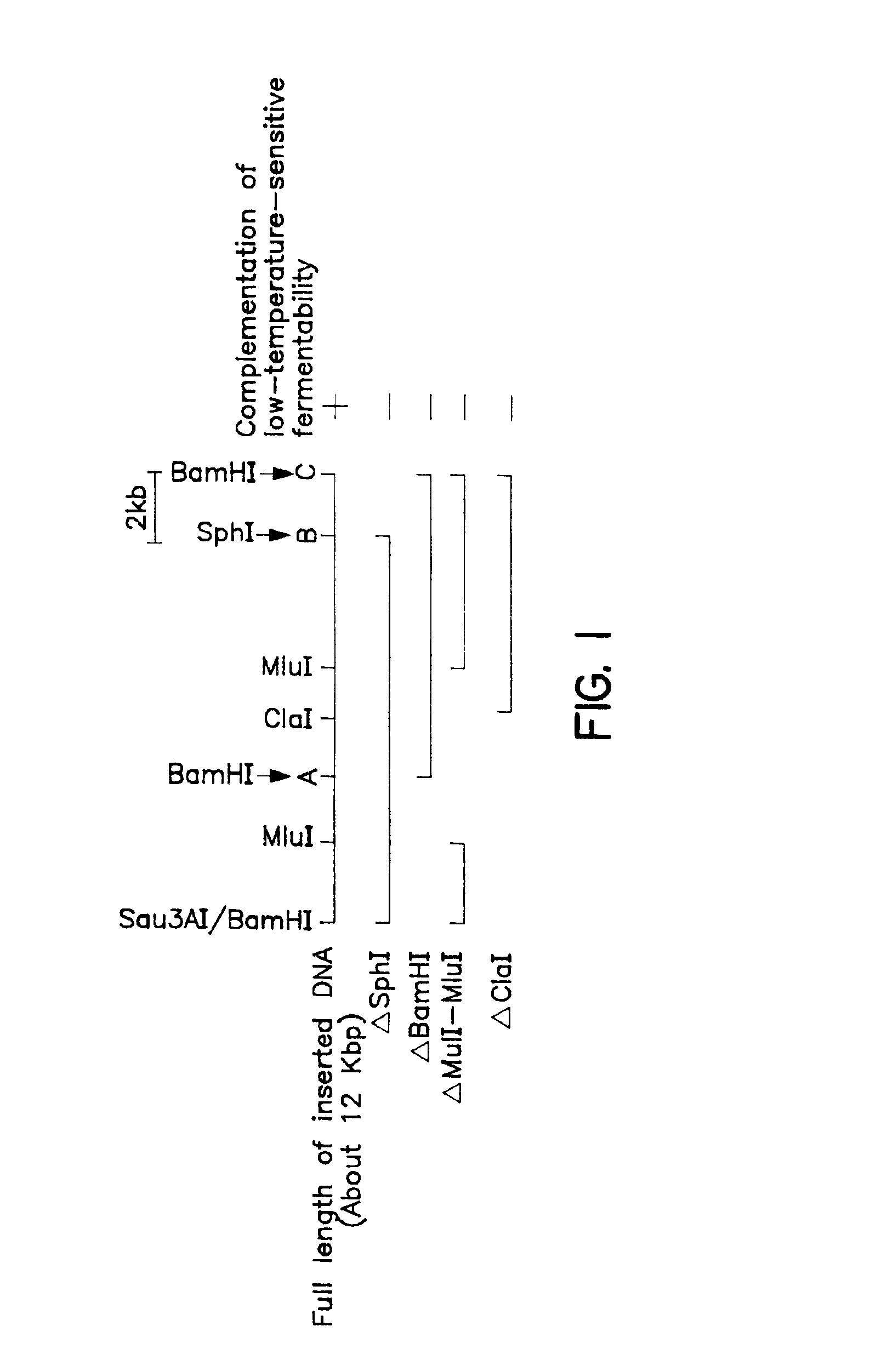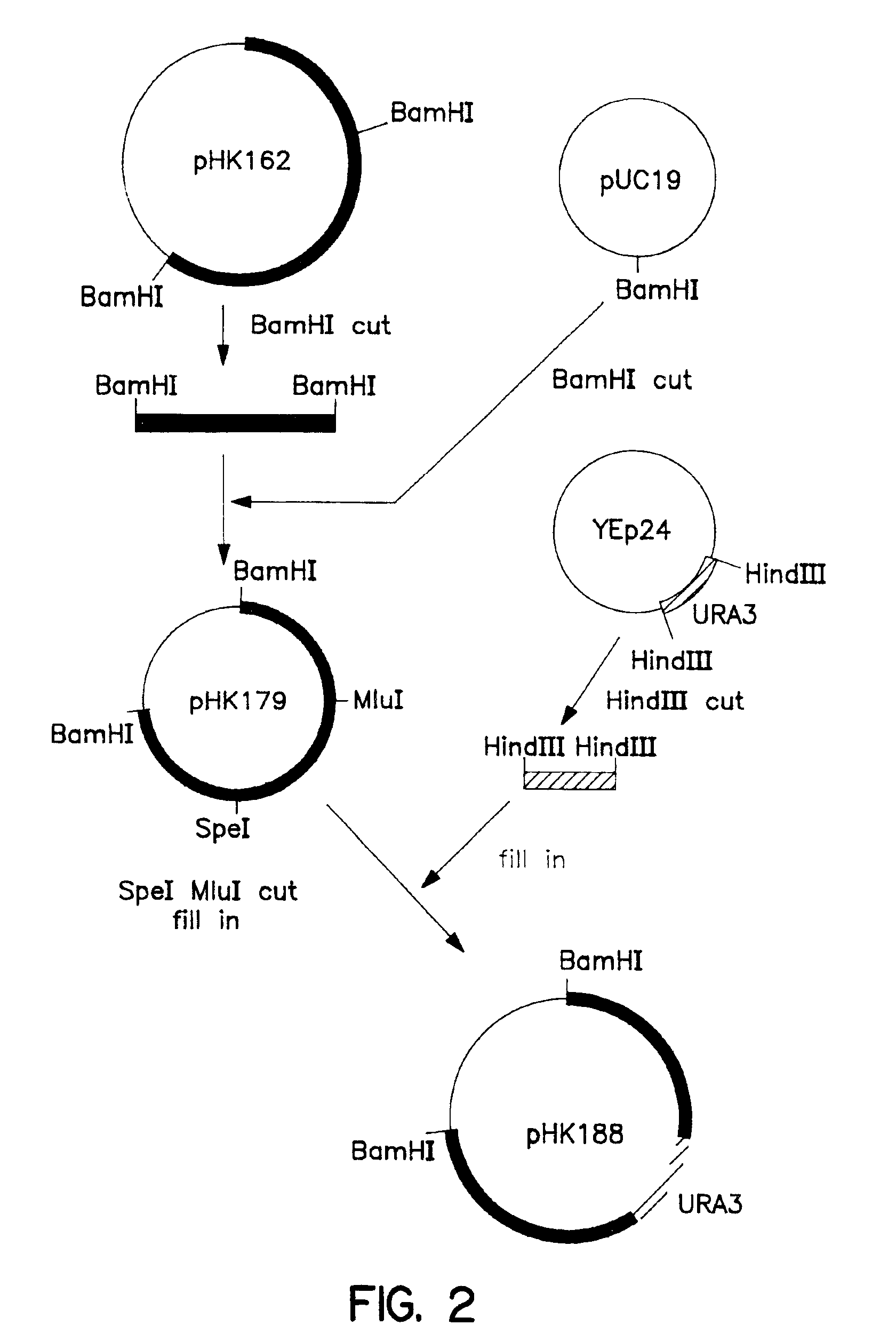Protein complementing yeast low temperature-sensitivity fermentability
a technology of protein and yeast, which is applied in the field of process for making bread with refrigerated dough and a process for producing ethanol, can solve the problems of affecting the fermentation process, and affecting the fermentation process, and achieves the effect of improving the low temperature sensitivity of the yhk1243 strain
- Summary
- Abstract
- Description
- Claims
- Application Information
AI Technical Summary
Benefits of technology
Problems solved by technology
Method used
Image
Examples
example 1
Cloning of the Gene Complementing Low-temperature-sensitivity
(1) Conferment of ura3 Mutation on RZT-3 Strain
[0073]RZT-3 strain, which is a yeast strain having low-temperature-sensitive fermentability, was conferred with ura3 mutation as a marker for introducing a plasmid according to the method of Boeke, et al. [Mol. Gen. Genet., 197, 345-346 (1984)]. That is, one loopful of RZT-3 strain was inoculated into YPD medium and cultured overnight at 30° C. with shaking. The resulting culture (100 μl) was smeared on FOA plate [0.67% Yeast Nitrogen Base w / o Amino Acid (Difco Laboratories Inc.), 0.1% 5-fluoroorotic acid, 0.005% uracil, 2% glucose, and 2% agar], and cultured at 30° C. for 3 days. From the colonies formed by the culturing was selected a strain having uracil-requirement which is complemented by transformation with plasmid YCP50 carrying URA3 as a marker, and having low-temperature-sensitive fermentability. This strain was designated Saccharomyces cerevisiae RZT-3u (hereinafter ...
example 2
Preparation of Yeast Having Low-temperature-sensitive Fermentability
(1) Construction of Plasmid for Gene Disruption
[0080]About 5 μg of pHK162 plasmid DNA was dissolved in 20 μl of H buffer [50 mM Tris hydrochloride buffer (pH 7.5), 10 mM magnesium chloride, 1 mM dithiothreitol, and 100 mM sodium chloride], and 10 units of restriction enzyme BamHI was added thereto. Reaction was carried out at 30° C. for 3 hours, followed by separation of the reaction product by 0.8% agarose gel electrophoresis. The segment of the gel containing the band of the DNA fragment of about 8 kb from BamHI (A) to BamHI (C) shown in FIG. 1 was cut out, and the fragment was extracted and purified by using GENECLEAN II Kit (Bio 101 Co., Ltd.). The same procedure as above was repeated except that about 5 μg of pUC19 plasmid DNA was used in place of about 5 μg of pHK162 plasmid DNA, whereby a DNA fragment of about 2.8 kb was extracted and purified. The DNA fragment of about 8 kb derived from plasmid pHK162 (1 μg)...
example 3
Process for Making Bread with Refrigerated Dough
(1) Culturing of Baker's Yeast
[0085]YOY655 strain and YHK1243 strain were respectively cultured in the following manner. That is, one loopful of each strain was inoculated into 30 ml of YPD medium in a 300-ml Erlenmeyer flask, and cultured at 30° C. for 24 hours. The whole of the resulting culture was inoculated into 270 ml of a molasses medium (3% molasses, 0.193% urea, 0.046% potassium dihydrogenphosphate, and 2 drops of defoaming agent) in a 2-l Erlenmeyer flask with baffles, and cultured at 30° C. for 24 hours. After the completion of culturing, the cells were collected by centrifugation and washed twice with deionized water, followed by dehydration on a clay plate. The obtained cells were used for making bread.
(2) Preparation of Bread
[0086]Bread was made according to the following dough composition and steps.
[0087]
(weight: g)Dough Composition:Hard flour100Sugar5Salt2Yeast cells2Water62Steps:Mixing(100 rpm, 2 minutes)Dividing(34.4 ...
PUM
| Property | Measurement | Unit |
|---|---|---|
| temperature | aaaaa | aaaaa |
| temperature | aaaaa | aaaaa |
| temperature | aaaaa | aaaaa |
Abstract
Description
Claims
Application Information
 Login to View More
Login to View More - R&D
- Intellectual Property
- Life Sciences
- Materials
- Tech Scout
- Unparalleled Data Quality
- Higher Quality Content
- 60% Fewer Hallucinations
Browse by: Latest US Patents, China's latest patents, Technical Efficacy Thesaurus, Application Domain, Technology Topic, Popular Technical Reports.
© 2025 PatSnap. All rights reserved.Legal|Privacy policy|Modern Slavery Act Transparency Statement|Sitemap|About US| Contact US: help@patsnap.com


